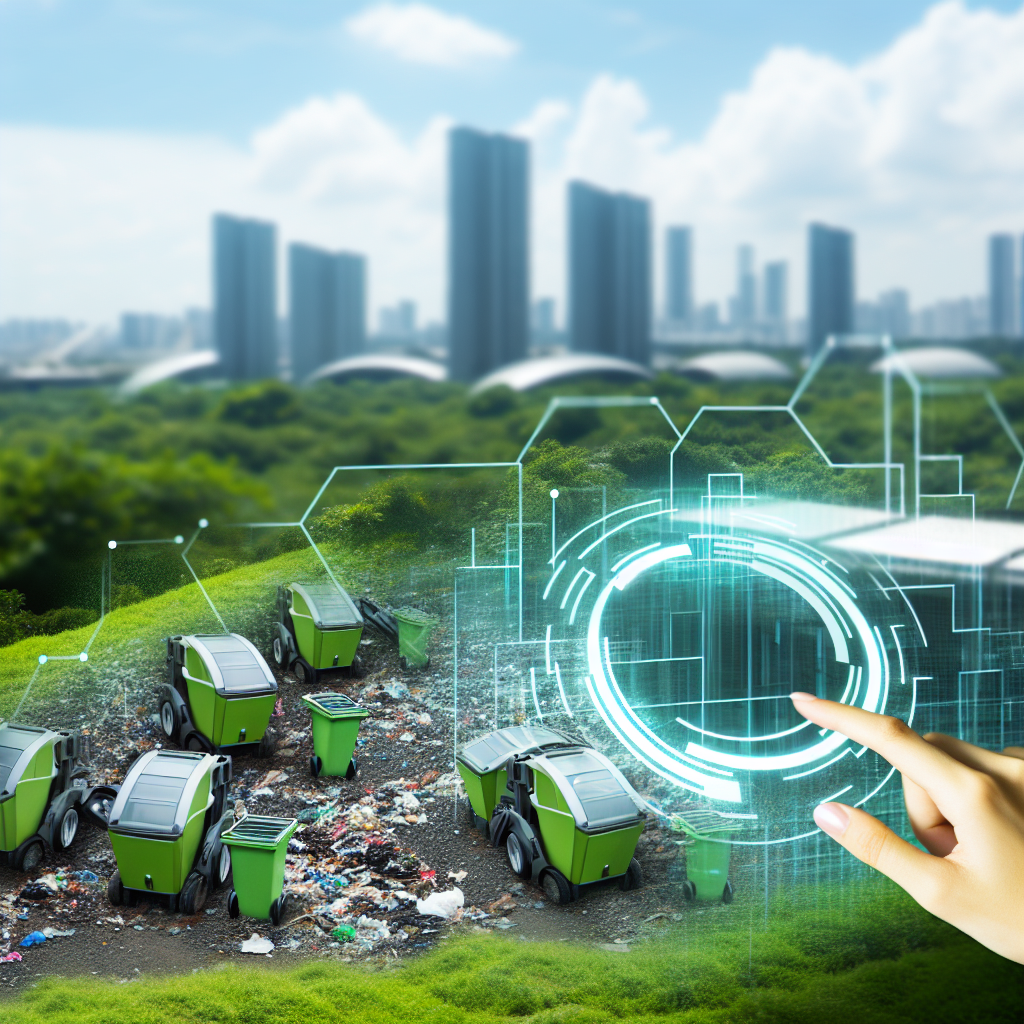Revolutionizing Waste Management: The Role of IoT in Valet Trash Services by 2025
As we approach 2025, the landscape of waste management is poised for a significant transformation, driven by the integration of Internet of Things (IoT) technologies into valet trash services. This evolution is not merely a response to the growing demand for efficiency and sustainability but also a testament to the innovative spirit that characterizes the modern waste management industry. By leveraging IoT, valet trash services are set to revolutionize how waste is collected, monitored, and processed, offering a glimpse into a future where technology and environmental stewardship go hand in hand.
To begin with, IoT technology enables real-time monitoring and data collection, which are crucial for optimizing waste management processes. Sensors embedded in trash receptacles can provide valuable data on fill levels, allowing service providers to schedule collections more efficiently. This not only reduces unnecessary trips, thereby lowering carbon emissions, but also ensures that waste is collected before bins overflow, maintaining cleanliness and hygiene in residential complexes. Moreover, the data collected can be analyzed to identify patterns and trends, enabling service providers to anticipate peak usage times and adjust their operations accordingly.
In addition to optimizing collection schedules, IoT technology facilitates enhanced communication between service providers and residents. Through mobile applications, residents can receive notifications about collection times, report issues, or request additional services. This level of interaction not only improves customer satisfaction but also fosters a sense of community involvement in waste management practices. Furthermore, the integration of IoT with mobile platforms allows for seamless billing and payment processes, streamlining operations for both service providers and residents.
Another significant advantage of IoT in valet trash services is its potential to improve recycling rates. Smart bins equipped with sensors can identify and sort recyclable materials, reducing contamination and increasing the efficiency of recycling processes. By providing residents with feedback on their recycling habits, these systems can encourage more responsible waste disposal practices. Additionally, the data collected can be used to develop targeted educational campaigns, further promoting sustainable behaviors within communities.
As we look towards 2025, the role of IoT in valet trash services extends beyond operational efficiencies and customer engagement. It also encompasses the broader goal of environmental sustainability. By reducing the frequency of collections and optimizing routes, IoT technology contributes to a decrease in fuel consumption and greenhouse gas emissions. Moreover, the ability to monitor and manage waste streams more effectively supports the transition towards a circular economy, where resources are reused and recycled rather than discarded.
In conclusion, the integration of IoT technology into valet trash services represents a significant step forward in the evolution of waste management. By enhancing operational efficiency, improving customer engagement, and promoting environmental sustainability, IoT is set to redefine the industry by 2025. As service providers continue to innovate and adapt to the changing landscape, the potential for IoT to drive positive change in waste management practices becomes increasingly apparent. Ultimately, the successful implementation of these technologies will depend on collaboration between service providers, residents, and policymakers, ensuring that the benefits of IoT are realized across all levels of society. As we embrace this new era of waste management, the promise of a cleaner, more sustainable future is within reach.
Smart Trash Solutions: How Automated Collection is Transforming Valet Trash Services
In recent years, the landscape of valet trash services has undergone a significant transformation, driven by technological advancements and innovative solutions. As we look towards 2025, the integration of smart trash solutions is poised to revolutionize the way these services operate, offering enhanced efficiency and convenience. At the heart of this transformation is the adoption of automated collection systems, which are set to redefine the traditional model of valet trash services.
Automated collection systems leverage cutting-edge technology to streamline the process of waste collection, making it more efficient and less labor-intensive. These systems utilize sensors and Internet of Things (IoT) devices to monitor waste levels in real-time, providing valuable data that can be used to optimize collection schedules. By doing so, they ensure that waste is collected only when necessary, reducing the frequency of collections and minimizing the environmental impact associated with excessive vehicle emissions.
Moreover, the implementation of smart bins equipped with compactors and odor control mechanisms further enhances the efficiency of valet trash services. These bins can compress waste, allowing for greater storage capacity and reducing the need for frequent emptying. Additionally, odor control features help maintain a pleasant environment, addressing one of the common concerns associated with waste management in residential communities.
Transitioning to automated collection systems also offers significant cost savings for property managers and service providers. By optimizing collection routes and schedules, these systems reduce fuel consumption and vehicle wear and tear, leading to lower operational costs. Furthermore, the data collected from smart bins can be analyzed to identify patterns and trends, enabling service providers to make informed decisions and improve their overall service delivery.
In addition to operational efficiencies, smart trash solutions contribute to enhanced customer satisfaction. Residents benefit from a more reliable and responsive service, as waste is collected promptly and efficiently. The use of mobile applications and digital platforms allows residents to communicate directly with service providers, report issues, and receive updates on collection schedules. This level of transparency and communication fosters a sense of trust and accountability, enhancing the overall customer experience.
As we move towards 2025, the integration of artificial intelligence (AI) and machine learning into valet trash services is expected to further elevate the capabilities of automated collection systems. AI algorithms can analyze data from various sources to predict waste generation patterns, enabling service providers to anticipate demand and allocate resources accordingly. Machine learning models can also be used to optimize collection routes in real-time, taking into account factors such as traffic conditions and weather, ensuring timely and efficient service delivery.
The adoption of smart trash solutions is not without its challenges, however. Initial setup costs and the need for ongoing maintenance and updates can be significant barriers for some service providers. Additionally, concerns around data privacy and security must be addressed to ensure that residents’ information is protected. Despite these challenges, the potential benefits of automated collection systems make them an attractive proposition for the future of valet trash services.
In conclusion, the integration of smart trash solutions and automated collection systems is set to transform valet trash services by 2025. Through enhanced efficiency, cost savings, and improved customer satisfaction, these innovations promise to redefine the way waste is managed in residential communities. As technology continues to evolve, the potential for further advancements in this field remains vast, paving the way for a more sustainable and efficient future in waste management.
Innovative Waste Innovations: The Future of Modern Valet Trash Tech in 2025
As we look toward 2025, the landscape of valet trash services is poised for a transformative evolution, driven by technological advancements and innovative ideas. The integration of cutting-edge technology into waste management processes is not only enhancing efficiency but also promoting sustainability and convenience. This shift is particularly evident in the realm of valet trash services, where innovation is redefining traditional practices and setting new standards for the industry.
One of the most significant technological innovations in valet trash services is the implementation of smart waste management systems. These systems utilize Internet of Things (IoT) technology to optimize the collection and disposal of waste. By equipping trash bins with sensors, service providers can monitor fill levels in real-time, allowing for more efficient route planning and reducing unnecessary trips. This not only minimizes fuel consumption and carbon emissions but also ensures that waste is collected promptly, enhancing the overall customer experience.
In addition to IoT, artificial intelligence (AI) is playing a pivotal role in revolutionizing valet trash services. AI algorithms can analyze data collected from smart sensors to predict waste generation patterns and optimize collection schedules. This predictive capability enables service providers to allocate resources more effectively, ensuring that waste is managed in a timely and cost-efficient manner. Furthermore, AI-driven analytics can provide valuable insights into consumer behavior, helping companies tailor their services to meet the specific needs of different communities.
Another innovative idea gaining traction in the industry is the use of autonomous vehicles for waste collection. These self-driving vehicles are equipped with advanced navigation systems and robotic arms, allowing them to collect trash without human intervention. By eliminating the need for manual labor, autonomous vehicles can operate around the clock, increasing the frequency and reliability of waste collection services. Moreover, the use of electric-powered autonomous vehicles aligns with the growing emphasis on sustainability, reducing the carbon footprint associated with traditional waste collection methods.
The integration of blockchain technology is also emerging as a game-changer in valet trash services. Blockchain can enhance transparency and accountability by providing a secure and immutable record of waste management activities. This technology can be used to track the entire lifecycle of waste, from collection to disposal, ensuring compliance with environmental regulations and promoting responsible waste management practices. Additionally, blockchain can facilitate seamless transactions between service providers and customers, streamlining billing processes and reducing administrative overhead.
As we move closer to 2025, the focus on sustainability is driving the development of eco-friendly waste disposal solutions. Innovations such as waste-to-energy technologies are gaining momentum, converting waste into renewable energy sources. This not only reduces the volume of waste sent to landfills but also contributes to the generation of clean energy, supporting global efforts to combat climate change. Furthermore, the adoption of biodegradable and recyclable materials in packaging is becoming increasingly prevalent, reducing the environmental impact of waste.
In conclusion, the future of valet trash services in 2025 is characterized by a seamless integration of technology and innovation. From smart waste management systems and AI-driven analytics to autonomous vehicles and blockchain technology, these advancements are reshaping the industry and setting new benchmarks for efficiency, sustainability, and customer satisfaction. As these innovations continue to evolve, they hold the promise of transforming valet trash services into a model of modern waste management, paving the way for a cleaner and more sustainable future.
Discover the future of waste management with cutting-edge technology and innovations in valet trash services. Explore innovative ideas for 2025 that are set to revolutionize the industry. Learn more today!



